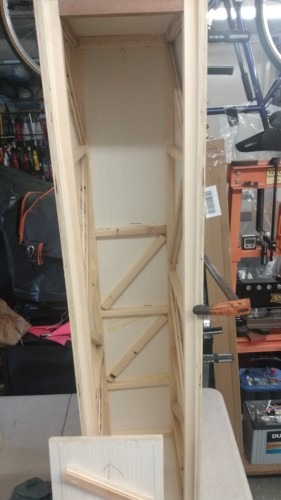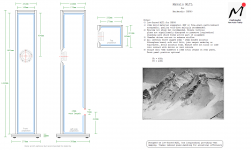Yes, apparently. I just tried to analyze it from the transmission line perspective. Specifically King's adaptation of Dickson's tables for TLs.There are no alignment tables for tapped corner horns that I am aware of; I manually calculated each of the FH series (and dropped Dave in it by getting him to draw & refine them.)
So, I'm investigating the upgrade from my FH3s to XLs. Why? Well the FH3s sound absolutely fabulous but with some tracks the bass is lacking grunt to what im used too. Is it the fact Ive hit the design limit, therefore will the XL gain it back, or should I be looking at a Pensil or other design?
Last edited by a moderator:
Probably reached the limit of FH3 -at the end of the day, there's only so much a 4in driver in a relatively compact horn can do, so all other things being equal, the larger you go, the more air you're going to shift, which on a simplistic level is what counts in the LF if you're after that physical impact. There's a reason why the pioneers liked their big high quality woofers (as do I, but no space. Or money  ).
).
hello hmj:
If you really like the FH3, a possible solution is a pair of self powered "sub" woofers. This is the way I ended up going with my system. I have the A10P En in the Frugal horn XL. I found that it still lacked the bass drive I like. I chose a set of inexpensive Pioneer self powered 8" subs to keep things small. I tuned the crossover point by ear from my comfy chair. I am very pleased with the outcome. I drive them from the high level input, Things seem to work well.
I hope this helps
If you really like the FH3, a possible solution is a pair of self powered "sub" woofers. This is the way I ended up going with my system. I have the A10P En in the Frugal horn XL. I found that it still lacked the bass drive I like. I chose a set of inexpensive Pioneer self powered 8" subs to keep things small. I tuned the crossover point by ear from my comfy chair. I am very pleased with the outcome. I drive them from the high level input, Things seem to work well.
I hope this helps
Last edited by a moderator:
Thanks. I'd rather stick to a box solution if I can. I'm going to explore other designs first and go from there.hello hmj:
If you really like the FH3, a possible solution is a pair of self powered "sub" woofers. This is the way I ended up going with my system. I have the A10P En in the Frugal horn XL. I found that it still lacked the bass drive I like. I chose a set of inexpensive Pioneer self powered 8" subs to keep things small. I tuned the crossover point by ear from my comfy chair. I am very pleased with the outcome. I drive them from the high level input, Things seem to work well.
I hope this helps
I'm now looking at the Pensil CHP-90 Scott, or other design that may sort it. Is that likely to produce the low bass I'm after? its more about reproducing the low notes rather than the power or does it become one and the same?Probably reached the limit of FH3 -at the end of the day, there's only so much a 4in driver in a relatively compact horn can do, so all other things being equal, the larger you go, the more air you're going to shift, which on a simplistic level is what counts in the LF if you're after that physical impact. There's a reason why the pioneers liked their big high quality woofers (as do I, but no space. Or money).
Last edited by a moderator:
Sort of. Basically we can go low, but for a given driver, that usually comes at the expense of outright power handling, i.e. how loud it can get. Basic rule of thumb: each time you lower tuning by 1 octave, driver excursion quadruples. That's why larger drivers tend to have an advantage in the LF as they've got the cone area to shift air without needing to reach large excursions. It's not quite as simple as that (groan) because different boxes load differently, but it gives a general idea what goes on.
What works out best will depend on what sort of material you're listening to, room size, how far away from the speakers you are, how loud your average listening level is, and how much headroom you need in the low frequencies to handle a sudden peak (somebody boots a big drum, explosion in MI: Fallout or similar). If you can give a rough estimate, we can probably figure what direction might work well.
What works out best will depend on what sort of material you're listening to, room size, how far away from the speakers you are, how loud your average listening level is, and how much headroom you need in the low frequencies to handle a sudden peak (somebody boots a big drum, explosion in MI: Fallout or similar). If you can give a rough estimate, we can probably figure what direction might work well.
Sure, music genre is Jazz mostly simple recorded Trio's and Quartet's. Think Bob James etc. Room size L4.88m x W3.36m, however listening area is contained to a smaller area of L3.63m x W2.27m. Distance between speakers is 1.82m with listening position at 2.67m away. Terraced house restricts max volume to 60db max. with average about 45 db.Sort of. Basically we can go low, but for a given driver, that usually comes at the expense of outright power handling, i.e. how loud it can get. Basic rule of thumb: each time you lower tuning by 1 octave, driver excursion quadruples. That's why larger drivers tend to have an advantage in the LF as they've got the cone area to shift air without needing to reach large excursions. It's not quite as simple as that (groan) because different boxes load differently, but it gives a general idea what goes on.
What works out best will depend on what sort of material you're listening to, room size, how far away from the speakers you are, how loud your average listening level is, and how much headroom you need in the low frequencies to handle a sudden peak (somebody boots a big drum, explosion in MI: Fallout or similar). If you can give a rough estimate, we can probably figure what direction might work well.
Best way to describe issue is by one typical example. Tracy Chapmans track Mountains of things at the beginning has a bassline that drops low. the lowest note should reverberate to what I'm used to on largeish speakers I've had, yet just flattens out on the FH3. Hope this helps.
There are other examples.I had that happen to me with one song on one system.
Turned out it was the reverberation that was the anomaly.
Don't know the song or what it's supposed to sound like but that's worth checking out for context, no?
Looks like it Nandappe, but I'm using FH3s with CHP90M. I am suspecting like others have mentioned the FH3 has reached it's cutoff point at >= 40Hz. So likely in the domain of larger speakers like the Bib/IBIB, CHP90 Pensil, your TQWT DDVP-15 and the FHXL.Dear hmj,
If you compare the original sound spectra with the playback spectra, you can see the frequencies where the sound pressure is lacking.
In the original sound, 36Hz appears around 42 seconds, and I think FH-XL is reproducing it well enough.
View attachment 1116417
Last edited by a moderator:
Given the modest area & low average SPLs, I suspect FHXL should do; within the context of compact horns, I've yet to hear anybody complain about its LF performance.Sure, music genre is Jazz mostly simple recorded Trio's and Quartet's. Think Bob James etc. Room size L4.88m x W3.36m, however listening area is contained to a smaller area of L3.63m x W2.27m. Distance between speakers is 1.82m with listening position at 2.67m away. Terraced house restricts max volume to 60db max. with average about 45 db.
Best way to describe issue is by one typical example. Tracy Chapmans track Mountains of things at the beginning has a bassline that drops low. the lowest note should reverberate to what I'm used to on largeish speakers I've had, yet just flattens out on the FH3. Hope this helps.
Since you mention CHP90, of the current boxes I've done for it & are up on the MA site, Bluebuck gets lowest, followed by the DCR, Pensil CHP90 and Psamathe RTL. They all have different alignments though (I aim to please
 ) so subjective impressions will vary between the boxes (no comment
) so subjective impressions will vary between the boxes (no comment Attachments
Last edited:
Thank you Scott. Given the wife kicking off with the last tall speaker I built (Your CHN110 FestivaL) I'd best walk away from that one  But I like that Bluebuck design and the Pensil!. Can you share the Fb, F3 and F6 figures please. don't seem to be on there?
But I like that Bluebuck design and the Pensil!. Can you share the Fb, F3 and F6 figures please. don't seem to be on there?
Last edited by a moderator:
Scott
This project came up on my "feed" as I've been looking at Pensils and FHXLs...
http://rvbprecision.com/stereo/building-pensil-10-2-speakers.html
This chap "dampens" the 1/2" panels with "diffusion blocks"... whatever those are.
Dave suggested side-to-side and front-to-back bracing. I was wondering if the volume of "blocks" and bracing needed to be considered in sizing the box... if one adds bracing or thickens the front panel -- I've been considering both -- does the box size need to change to keep the internal volume as designed?
This project came up on my "feed" as I've been looking at Pensils and FHXLs...
http://rvbprecision.com/stereo/building-pensil-10-2-speakers.html
This chap "dampens" the 1/2" panels with "diffusion blocks"... whatever those are.
Dave suggested side-to-side and front-to-back bracing. I was wondering if the volume of "blocks" and bracing needed to be considered in sizing the box... if one adds bracing or thickens the front panel -- I've been considering both -- does the box size need to change to keep the internal volume as designed?
Yes the volume of any solids in the box to brace or diffuse has to be accounted for.
http://rvbprecision.com/stereo/building-pensil-10-2-speakers.html )the link posted above yields a 404 for mr, googlr turns this up which does not look any different)

Very crude and not that effective bracing.
dave
http://rvbprecision.com/stereo/building-pensil-10-2-speakers.html )the link posted above yields a 404 for mr, googlr turns this up which does not look any different)

Very crude and not that effective bracing.
dave
- Home
- Loudspeakers
- Full Range
- Frugel-Horn XL for Alpair 10.3/10p, Fostex FF165wk, more
